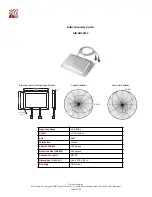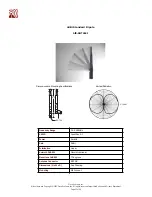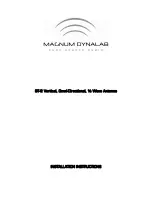
Cisco Systems, Inc.
All contents are Copyright © 2003 Cisco Systems, Inc. All rights reserved. Important Notices and Privacy Statement.
Page 7 of 29
• Small Office/Small Retail—The standard dipole may provide adequate coverage in these areas depending upon the location of
the radio device. However, in a back corner office a patch antenna may provide better coverage. It can be mounted to the wall
above most obstructions for best performance. Coverage of this type antenna depends upon the surrounding environment.
• Enterprise/ Large Retail—In most cases, these installations require a large coverage area. Experience has shown that
omni-directional antennas mounted just below the ceiling girders or just below the drop ceiling typically provide the best
coverage (this will vary with stocking, type of material and building construction). The antenna should be placed in the center
of the desired coverage cell and in an open area for best performance. In cases where the radio unit will be located in a corner,
or off to one end of the building a directional antenna such as a patch or yagi can be used for better penetration of the area.
Also for areas that are long and narrow, such as long rows of racking, a directional antenna, used at one end may provide better
coverage. The radiation angle of the antennas will also affect the coverage area.
• Point-to-Point—When connecting two points together (such as an Ethernet bridge), the distance, obstructions, and antenna
location must be considered. If the antennas can be mounted indoors and the distance is very short (several hundred feet), the
standard dipole or mast mount 5.2 dBi omni-directional may be used. An alternative is to use two patch antennas. For very long
distances (1/2 mi. or more) directional high gain antennas must be used. These antennas should be installed as high as possible,
and above obstructions such as trees, buildings, and so on; and if the directional antennas are used, they must be aligned so that
their main radiated power lobes are directed at each other. With a line-of-site configuration, distances of up to 25 miles at
2.4GHz can be reached using parabolic dish antennas, if a clear line-of-site is maintained. With the use of directional antennas,
you are subject to fewer interference possibilities, and less likely to cause interference to anyone else.
• Point-to-Multipoint Bridge—In this case (in which a single point is communicating to several remote points) the use of an
omni-directional antenna at the main communication point must be considered. The remote sites can use a directional antenna
that is directed at the main point antenna.
Cabling
As stated above, cabling introduces losses into the system, negating some of the gain an antenna introduces, and reducing range of
the RF coverage.
Interconnect Cable
Attached to all antennas (except the standard dipoles), this cable provides a 50 Ohm impedance to the radio and antenna, with a
flexible connection between the two items. It has a high loss factor and should not be used except for very short connections (usually
less than 10 feet). Typical length on all antennas is 36" (or 12" on some outdoor antennas).
Low Loss/Ultra Low Loss Cable
This cable provides a much lower loss factor than the interconnect cable, and it is used when the antenna must be placed at any
distance from the radio device. While it is a low loss cable, it should still be kept to a minimum length. This cable is the only cable
type supplied by Cisco for mounting the antenna away from the radio unit. It is offered in four different lengths with one RTNC
plug and one RTNC jack connector attached. This allows for connection to the radio unit and to the interconnect cable supplied
on the antennas.
Connectors
Connectors used on equipment manufactured after June 1994 must be unique, nonstandard connectors (per FCC and DOC
regulations). Therefore, Cisco Aironet products use a connector known as Reverse-TNC (RTNC) connectors. While they are similar
to the normal TNC connectors, they cannot be mated to the standard connectors. To ensure compatibility with Cisco Aironet
products, use antennas and cabling from Cisco.







































